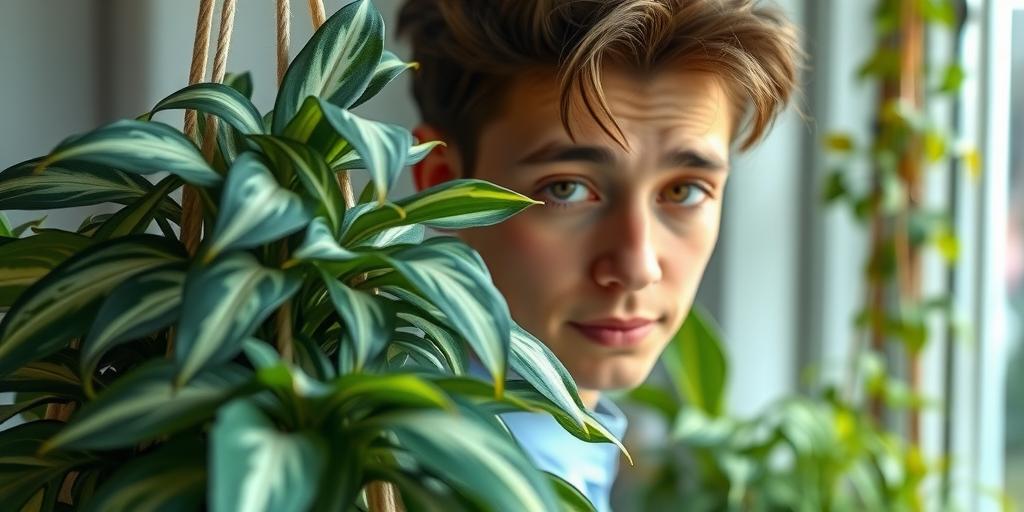
How to Care for Variegated Low Light Hanging Plants: Essential Tips and Tricks
Learn how to care for variegated low light hanging plants with expert tips! Discover the best watering, lighting, and maintenance tricks to keep your indoor plants thriving.
Introduction
Did you know that variegated plants can brighten up even the darkest corners of your home? These stunning low light hanging plants, with their unique patterns and easy-care nature, are perfect for adding life to any space. But keeping them healthy requires the right balance of light, water, and care. Whether you’re a beginner or a seasoned plant parent, this guide will walk you through everything you need to know to keep your variegated beauties lush and vibrant!
Choosing the Right Variegated Low Light Hanging Plants
When selecting variegated hanging plants for low-light spaces, some varieties naturally thrive better than others. Pothos (Epipremnum aureum) is a classic choice—its marbled or golden variegation adds visual interest while tolerating dim corners. Philodendrons, especially the heartleaf variety, are another excellent option, with their trailing vines and speckled leaves. Spider Plants (Chlorophytum comosum) also adapt well to low light, though their variegation may become less pronounced without some indirect sunlight.
Before buying, inspect the plant carefully. Healthy leaves should be firm and free of brown spots or yellowing, which could indicate stress or disease. Gently check the roots—if they’re peeking out of the drainage holes or feel mushy, the plant may be root-bound or overwatered.
Variegation affects a plant’s light needs because the white or yellow parts lack chlorophyll, making them less efficient at photosynthesis. This means variegated plants often need slightly brighter indirect light than their all-green counterparts to maintain their patterns. If placed in too dim a spot, they may revert to solid green to compensate.
Ideal Lighting Conditions for Variegated Hanging Plants
Variegated hanging plants prefer bright, indirect light—think near a north-facing window or a few feet away from an east or west-facing one. Direct sunlight can scorch their delicate leaves, especially those with lighter variegation.
Signs of too much light include bleached or crispy leaf edges, while too little light leads to faded variegation and leggy, stretched-out growth as the plant reaches for light. If your plant starts losing its vibrant patterns, try moving it closer to a light source (but not directly in the sun).
The best spots in your home? Bathrooms with frosted windows, living rooms with sheer curtains, or hallways with ambient light are great choices. Just avoid dark corners unless you’re using a grow light to supplement.
Watering Techniques for Healthy Growth
Overwatering is the fastest way to kill a variegated hanging plant. Check the soil moisture before watering—stick your finger an inch deep; if it’s dry, it’s time to water. If it’s still damp, wait a few more days. Most low-light plants need water every 1-2 weeks, but this varies based on humidity and pot size.
Signs of overwatering include yellowing leaves and a musty smell from the soil. Underwatering shows up as drooping, crispy leaves. Always water thoroughly until it drains out the bottom, then empty the saucer to prevent root rot.
For the best results, use filtered or distilled water, especially if your tap water is hard or heavily chlorinated. Some plants (like spider plants) are sensitive to fluoride, which can cause brown leaf tips.
Soil and Potting Tips for Optimal Drainage
Variegated hanging plants need well-draining soil to avoid soggy roots. A mix of peat moss, perlite, and orchid bark works well, providing aeration and moisture retention without compaction. Avoid dense, heavy soils that stay wet too long.
When choosing a pot, drainage holes are non-negotiable. Hanging baskets made of breathable materials like coco coir or woven plastic help prevent waterlogging. If your plant outgrows its pot (roots circling the bottom or poking out), repot in spring using fresh soil and a container just 1-2 inches larger.
Humidity and Temperature Requirements
Most variegated hanging plants are tropical, so they thrive in 40-60% humidity. Dry air can cause brown edges or leaf drop. Boost humidity by placing a pebble tray filled with water beneath the pot, grouping plants together, or using a small humidifier. Misting helps temporarily, but avoid overdoing it—wet leaves can invite fungal issues.
Keep temperatures between 65-80°F (18-27°C). Avoid drafts, air vents, or sudden temperature swings, which can stress the plant and dull its variegation.
Pruning and Maintenance for Fuller Growth
To encourage bushier growth, trim leggy vines just above a leaf node—this prompts new branches. Regularly pinch back tips to maintain shape. Clean leaves with a damp cloth to remove dust, which blocks light absorption and slows growth.
Propagation is easy with many variegated plants. Snip a 4-6 inch cutting below a node, place it in water or moist soil, and wait for roots to form. This is a great way to refresh an overgrown plant or share with friends.
Common Pests and How to Prevent Them
Variegated plants can attract spider mites, mealybugs, and aphids, especially if stressed. Check regularly for webbing, sticky residue, or tiny bugs on leaves. Neem oil or insecticidal soap sprayed weekly can treat infestations.
Prevent pests by keeping leaves clean, avoiding overwatering, and quarantining new plants before introducing them to your collection. Healthy plants are less likely to succumb to bugs.
Fertilizing for Vibrant Variegation
Use a balanced, water-soluble fertilizer (like 10-10-10) diluted to half strength every 4-6 weeks during the growing season (spring to summer). Reduce feeding in fall and winter when growth slows.
Signs of nutrient deficiency include pale leaves (nitrogen), weak stems (phosphorus), or brown edges (potassium). If variegation fades, try a fertilizer with micronutrients like magnesium, but avoid over-fertilizing—salt buildup can harm roots.
Conclusion
Caring for variegated low light hanging plants doesn’t have to be tricky! With the right light, water, and occasional pruning, your plants will thrive and add beauty to your home. Ready to transform your space with lush greenery? Start applying these tips today and watch your plants flourish!
